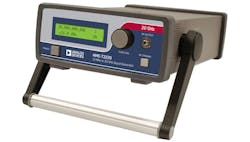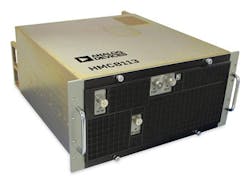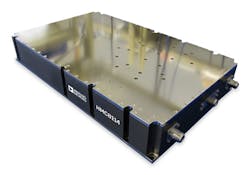Frequency Synthesizers Rack Up Performance to 20 GHz
This file type includes high resolution graphics and schematics when applicable.
One of the RF/microwave industry’s leading suppliers of integrated circuits (ICs) is also a major consumer of them—specifically, as part of higher-level electronic designs. Well-known for its data converters and receiver/transmitter ICs, Analog Devices is also adept at finding spots for many of its own ICs in block diagrams representing modules and even rack-mount systems for commercial, test, military, and even space applications.
As an example, the HMC-T2220 synthesized signal generator is a legacy product from the acquisition of Hittite Microwave Company a decade earlier that has been enhanced and upgraded to meet the needs of both avionics and automatic-test-equipment (ATE) applications. It is broadband, low in noise, and fast in switching speed, and manufactured alongside many of those smaller ICs that are more familiar to many high-frequency systems designers.
The HMC-T2220 synthesized signal generator (see figure) has the broad frequency range—10 MHz to 20 GHz—that makes it a candidate both for automated testing and adaptation to electronic-warfare (EW) systems. It is assembled with standard phase-locked-loop (PLL) frequency-synthesizer ICs as well as custom ICs developed specifically for this design, including tunable filters, a triplexer, eight-way multiplexer, a voltage-controlled oscillator (VCO), and a combination fractional-divider/phase-detector PLL with improved spurious performance.
These customized devices enable superior performance while reducing size, weight, power, and cost. Several mechanical configurations have been developed, including a robust, 19-in.-wide rack-mountable unit for harsh environments. Although perhaps not well known, Analog Devices has the capability to quickly turn a set of function and performance requirements into a custom design and follow-up production.
Having many of the necessary ICs close at hand (see sidebar) helps shorten lead times. With respect to designs featuring a heavy blend of analog and digital engineering, having the in-house expertise to combine RF, analog, and digital technologies at the device, circuit, and system levels offers major advantages toward achieving high circuit densities (small size)—with minimal power consumption and the highest reliability for critical applications.
Returning to the example of the HMC-T2220 synthesized signal generator, it was originally developed as a miniature test signal generator with high performance that could be easily moved around a research or manufacturing facility. It has been transformed into different versions, all with excellent broadband performance, but differing in digital functionality and control.
In general, the signal generator can tune quickly, with typical frequency switching speed of 300 µs and frequency tuning resolution of 1 Hz. It provides generous output power, with +24 dBm at 10 MHz, +26 dBm at 1 GHz, +25 dBm to 10 GHz, +24 dBm to 15 GHz, and +20 dBm to 20 GHz. Output power can be adjusted with 0.1-dB resolution. With the RF power switched off, the power at the RF output port measures −80 dBm. Output power accuracy is typically better than ±2 dB below 50 MHz and better than ±1 dB above 500 MHz.
The single-sideband (SSB) phase noise is typically −113 dBc/Hz offset 1 kHz from a 1-GHz carrier and −135 dBc/Hz offset 1 MHz from the same carrier, and typically −86 dBc/Hz offset 1 kHz from a 20-GHz carrier and −112 dBc/Hz offset 1 MHz from the same carrier. Spurious rejection is −57 dBc or better for all frequencies 10 GHz or greater and −65 dBc or better for all frequencies less than 10 GHz. Second harmonics are −31 dBc or better below 10 GHz and −55 dBc at 20 GHz. Third-harmonic levels are −44 dBc at 10 MHz, −52 dBc at 1 GHz, and −58 dBc at 10 GHz.
The frequency synthesizer can be operated manually or under computer control, via USB, GPIB, and Ethernet ports and a computer running drivers supplied with the synthesizer. The drivers and graphical user interface (GUI) software that accompanies them are compatible with Windows XP, Vista, and 7. It is one example of the system-level design capabilities that work with many of the company’s own ICs as building blocks. On a smaller scale, those design capabilities can also yield many other functions within a system block diagram, including power amplification (see sidebar).
Analog Devices Inc., One Technology Way, P.O. Box 9106, Norwood, MA 02062-9106; (781) 329-4700
GaN is Just the Start
To meet amplification demands in high-frequency systems, Analog Devices has invested in GaN as the semiconductor material of choice for high-power RF/microwave amplification. On a smaller scale than the frequency synthesizer, the company assembles hermetic high-power-amplifier (HPA) modules based on GaN monolithic microwave integrated circuits (MMICs), with all necessary power sequencing and biasing connections made to the die within the module packaging. The modules are manufactured and fully tested within Analog Devices and are conservatively rated to meet their stated performance levels over wide environmental operating conditions.
One example of the in-house-manufactured GaN HPAs is model HMC8113, which operates from 2 to 6 GHz with more than 500 W typical saturated output power. It is supplied in a rugged, rack-mount housing (Fig. 1) with self-contained power supply, along with bias sequencing and bias protection to prevent damage. The large enclosure includes sufficient heat sinking to provide suitable thermal management for the GaN semiconductors.
For broadband applications requiring a somewhat smaller enclosure, another example is model HMC8114 (Fig. 2), an HPA module with 90 W typical saturated output power from 6 to 18 GHz. The HMC8113 and HMC8114 are both ideal for EW applications. These and other GaN HPAs are designed with advanced thermal-management techniques and thermal modeling to minimize performance degradation due to self-heating effects. They incorporate numerous innovative design strategies, such as power-combining techniques developed to trim losses due to discontinuities and transmission-line mismatches. Many of the lessons learned in developing high-performance RF ICs are demonstrated in these higher-level modules and system-level assemblies.
This file type includes high resolution graphics and schematics when applicable.
About the Author
Jack Browne
Technical Contributor
Jack Browne, Technical Contributor, has worked in technical publishing for over 30 years. He managed the content and production of three technical journals while at the American Institute of Physics, including Medical Physics and the Journal of Vacuum Science & Technology. He has been a Publisher and Editor for Penton Media, started the firm’s Wireless Symposium & Exhibition trade show in 1993, and currently serves as Technical Contributor for that company's Microwaves & RF magazine. Browne, who holds a BS in Mathematics from City College of New York and BA degrees in English and Philosophy from Fordham University, is a member of the IEEE.





